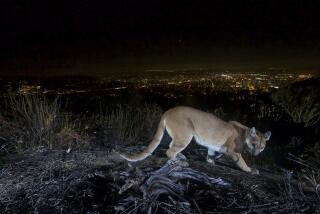Naturalist Takes His Love of the Rain Forests Home : Environment: Sherman Oaks scientist has a new book and a house that reflect his lifelong crusade to save the aged habitat from potential destruction.
Arnold Newman’s first trip into a rain forest in 1965 wasn’t the romantic pleasure cruise one might have expected. The Colombian army had agreed to take the young scientist-naturalist and his wife deep into the Amazon for a two-week expedition collecting rare or previously unknown plant and animal species.
As they flew with their guide in a small, single-engine craft toward the remote Sierra Macarena range, the plane didn’t have the power to rise above the thick clouds, taking them instead directly into rainstorms. One of the plane’s windows was stuck open and then a door unlatched, exposing them to the lightning and thunder. By the time they landed safely at the riverside drop-off point, Newman found that the army had failed to deliver the provisions it had promised--no food, no mosquito netting, nothing. And his guide was so rattled by the plane ride that he refused to stay.
But for Newman, his arrival at the thick jungle wall was the culmination of a longtime fascination with the natural world that began with boyhood trips to the swampy region of “Turtleland” in Upstate New York. That same fascination would guide his entire adult life and manifest itself spectacularly in his Sherman Oaks hillside house, which is crowded with primitive artifacts, ancient bones, and plant and animal life gathered during 25 years of traveling through the world’s rain forests and elsewhere. His lushly illustrated new book, titled “Tropical Rainforest” (Facts On File, $45), seeks to educate the public on the forest’s value and beauty.
On that first trip in the mid-’60s, Newman and his wife of three years, Arlene, stayed in the forest with only a small amount of bread, potatoes and chocolate they brought with them. They quickly met Indian hunter-gatherers who introduced them to the delicacies of indigenous fruit, turtle eggs, piranha, rat and snake meat. Although that two-week stay was spent mostly foraging for food, Newman said he found time to pause and stare up at the dazzling green vision of 250-foot-tall trees, cascading vines and the brilliantly active life above him.
“This always stayed with me: ‘My God, what did we see?’ My wife was a little less convinced,” Newman said of that first trip, reminiscing in his living room as the 8-foot-tall skeleton of a European cave bear hovered menacingly nearby. “She was picky about what she ate, and I would eat the monkeys and the snakes.”
Nonetheless, Newman’s wife and two children have often joined him on his many trips back to the forest every year, traveling through one or more of the 32 rain forest nations. Daytime television viewers might recognize the trim 49-year-old as the host for 14 years of the Emmy Award-winning “The Elementary News,” which ran until the early 1980s on KTTV. But Newman, a graduate of the University of Miami, now spends most of his time consulting and lobbying various governments on forest conservation, and leading tours of scientists into the jungle.
But these last several years have been overshadowed by a growing sense of urgency concerning the survival of this aged habitat. Its potential destruction, he explains in the new book, threatens not only scientific research, but the entire planet’s quality of life.
A rain forest typically receives about 80 inches of rainfall annually, Newman said, while 99% of sunlight is blocked out by the leafy canopy created by the tall trees and other vegetation. The forests, which cover about 7% of the Earth’s land, harbor about 90% of all life forms, including about 40% of all vegetation, much of it still undiscovered by scientists, said Newman.
He said massive timber cutting and burning in the forests of South America, Africa and elsewhere are “wrecking the global balances” by disrupting the absorption of carbon monoxide and dioxide into the forest vegetation. Instead, the carbon is released into the atmosphere, creating a layer that traps the sun’s rays and ultimately will lead to the “greenhouse effect,” or global warming.
Newman wrote his new book, he said, because “I felt there was great interest in these issues out there. . . I wanted to bring to a wide audience in a very lucid manner, a guardedly hopeful manner, that each one of us can do something to save the tropical rain forest. And we have every reason to.” An earlier book by Newman, “The Lungs of Our Planet,” was published in the Soviet Union and dealt with similar issues.
In addition to world rain forests’ impact on climate, Newman writes that much of their value is undiscovered and could affect diverse concerns in food and medicine. About 1.75 million world species are catalogued by scientists, he said, while some speculate that 50 million more await discovery in the forests. Many important medicines have been derived from ingredients first found there, he said, and pharmacists journey into the jungle when budgets permit.
One recent discovery in the fast-disappearing forests of Madagascar, for example, was the rosy periwinkle, which has been used to treat Hodgkin’s disease and acute lymphocytic leukemia. In his book, Newman quotes the United States Cancer Institute as stating that “the widespread elimination of the tropical moist forests could represent a serious setback for the anti-cancer campaign.”
Destruction of rain forests, Newman said, is leading to the loss of six species every day, and speculation is that it will escalate over the next several years to one species every hour. “By the turn of the century, that’s approximately nine years from today, we’re looking at the loss of over 1 million species on Earth,” Newman said. “Now, can we really afford that?”
The experience of confronting a spectacular, and previously undocumented, species hit Newman in a very dramatic way in 1983, when he and his then 13-year-old son, Gandhi, found in Sumatra what is believed to be the largest flower on Earth. At 38 pounds, and 38 inches wide, this new species of rafflesia has qualities other than mere size, Newman said with proud fascination.
“It looks like a dead animal, it smells like rotten meat and its bud takes three years to develop the size of a basketball, and it opens with the hiss of a cobra. Now, you’ve got to say that it’s a remarkable species.”
Newman spoke from the comfort of a soft chair in his Sherman Oaks house. Behind him gurgled a recently completed stream that runs just inside his front door and windows, where a pair of albino turtles mingled with the tropical plants and other life that fill the house and surrounding landscape. Earlier, Newman demonstrated a fog machine that created a thick cloudy layer that drifted from the stream and out over the living room.
Other rooms, stretching to a den in back of the house, were lined with shelves and spaces loaded with the bones of saber-toothed cats and relics of other ancient species. Green plants drape over the shelves, allowed to grow seemingly as free as the tall bamboo stalks outside.
The author-naturalist was cleanshaven as he talked of this collection, which still included the tooth of a prehistoric 50-foot shark that was given to him by his boyhood friend. Newman’s light brown hair was neatly combed, and he was dressed in a green tweed jacket and cowboy boots. He appeared much different in photographs taken in the field. Bearded and wearing sandals and khakis, Newman often travels through the forest, marking his trail through with a knife and sleeping in a hammock under mosquito netting. He continues to return there, and the early chapters of “Tropical Rainforest” offer subtle encouragement for readers to experience it themselves.
“Your first impression is that you smell this decay, and birth, and death and rebirth. It fills your nostrils,” he said. “It’s a very powerful experience that this is life, and life living off death and decay in a very efficient way.”
Newman’s book is one of a small group of recently published books examining the rain forests and their possible destruction. It’s probably a reflection of a new wave of mainstream concern over environmental issues since last year, suggested Campbell Plowden, international coordinator for the Greenpeace Tropical Forest Campaign. Plowden said books such as Newman’s demonstrate how Western nations contribute to the rain forest problem by purchasing products originating from destroyed forest areas.
“Anything that is in Arnold’s book that explains how they can take a look at their own lives and see how their money is being spent will offer an important contribution leading to a call for action,” Plowden said from his Washington, D.C., office. “We’re running a real race here, and certainly public concern has increased dramatically in the last couple of years. But that unfortunately is happening mainly in the non-tropical countries. And so far the general attitude is that it’s terrible, and ‘Why don’t those Brazilians and those Malaysians stop it?’ What has been seriously lacking is the responsibility of northern countries in recognizing their role in the deforestation equation.”
Such issues have engrossed Newman for more than two decades. And among the concrete byproducts of that has been establishment of the Cathedral Rain Forest Science Preserve in Costa Rica, a 1,000-acre stretch of government-protected rain forest set aside for scientific research. Closer to home, he helped establish Sherman Oaks’ own 100-acre Fossil Ridge Paleontological Park, which he and other environmentalists say is riddled with fossils that are 10 million years old. That land, within view of Newman’s house, was saved from destruction only after he and others held lengthy negotiations with developers.
But with all this work, beginning with that first visit in which he and his wife spent most of their stay just trying to avoid starvation, Newman said he has yet to simply take a pleasure trip into the forests that he’s spent so much time studying.
“One thing I’d like to do on one trip is go without this necessary agenda and simply enjoy the forest,” he said. “It’s a lot of hard work in the forest. The humidity is high, it’s hard to take care of your equipment and keep everything dry. To just aesthetically enjoy the forest would be an enormous luxury.”
Appleford is a regular contributor to Valley View.
combined caption for fotos slugged RAIN AND RAIN-1
More to Read
Sign up for our Book Club newsletter
Get the latest news, events and more from the Los Angeles Times Book Club, and help us get L.A. reading and talking.
You may occasionally receive promotional content from the Los Angeles Times.








